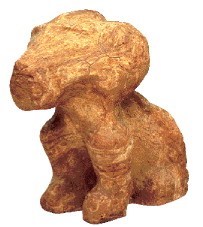The darkest recesses of our refrigerators can harbor ghastly things: spoiled milk, moldy bread, putrid fruit. When their odors offend, we grimace, then throw them out. But what if that fetid banana is art? What if the hallmarks of its decay--insects, mildew, rot--comprise its intentionally changing aesthetic?
 |
| Perishable art by German sculptor Dieter Roth: (above) Chocolate Lion (self portrait as a lion), chocolate, 1971, and (below, left) Small Sunset, sausage on blue and white paper in plastic sleeve, 1972. |
 |
| Photographs ©2001 President and Fellows of Harvard College, Harvard University Art Museums |
Traditionally, art conservators strove to keep their prized paintings looking new. But today's conservators sometimes treat works made of perishable, even edible, materials. This art is supposed to change over time, and stalling this process may contradict an artist's intentions. Determining those intentions has become a priority for conservators, who must balance them against the long-term interests of museums that have paid millions of dollars for single works. To avoid misinterpretation--and perhaps seek a compromise between preservation and decay--conservators now address artists directly.
At the Harvard University Art Museums' new Center for the Technical Study of Modern Art, founding director Carol Mancusi-Ungaro oversees the Artist Documentation Project, an ambitious enterprise to gather information from modern artists in order to preserve their works properly in the future. (The center is a partnership with New York's Whitney Museum of American Art, where Mancusi-Ungaro is director of conservation.) She has already interviewed 13 artists, including Jasper Johns and Cy Twombly, about their methods, intentions, and motives for specific works. In addition, she plans to have the project collect samples of artists' materials and paints, photographs of their studios, and fragments of their discarded or destroyed works. Such an archive could prove invaluable to conservators who will be able to test restoration techniques and study paint's chemical composition without harming the original work.
The project is particularly important in the case of artists who use nontraditional materials, such as chocolate, or unique concoctions of paint. Rabbit-skin glue, cigarette butts, and sand now cover some canvases; Jackson Pollock used industrial paints and Mark Rothko employed egg. If conservators remain ignorant of a mixture's ingredients, as well as of an artist's philosophical motives, they risk making uninformed choices that can cause irreparable damage. (Many experts, for example, believe Michelangelo would disapprove of the bright colors used in the recent Sistine Chapel restoration.) "Modern artists began using materials that were not customary or codified," Mancusi-Ungaro says. As the works age, "we have no place to go for technical information. We have to make educated guesses."
Mancusi-Ungaro's one-on-one interviews with artists, videotaped in front of their work, involve casual, open-ended conversations rather than laundry lists of paints. "I ask no specific questions, but just try to get some sense of who this person is," she explains. "What did he try to achieve by using this material?"
Dieter Roth, for example, chose to use organic materials to explore the visibility of time. He welcomed the inevitable decomposition of his works, such as a salami slice depicting a sunset. This year, Harvard's Busch-Reisinger Museum acquired Roth's rabbit sculpture, Shit Hare, made of dirt, hay, and rabbit feces. Mancusi-Ungaro is not sure how the piece will be preserved.
One way for artists to guarantee the integrity of their works is simply to forbid intervention. Sculptor Sonja Alhäuser, whose creations include gingerbread sculptures and boxes of pralines, has given conservators strict instructions: no heroic measures. Change--visible and biological--is integral to the meaning of Alhäuser's work. She believes art should stimulate all the senses, particularly smell and taste; this sensory interaction between viewer and sculpture is the art. Recently, the Busch-Reisinger commissioned her to create three chocolate sculptures. The four-foot high, box-like structures are intended to decay, as well as to be eaten, by museumgoers. The gallery in which they're displayed smells sweetly delectable, and bits of chocolate dropped by spectators hungry for art litter the floor.
But artists with such radical views are rare. Most want their works to endure, yet expect the natural effects of aging. "All art changes," Mancusi-Ungaro says. "It's just hard for us to accept it if we knew it when it was new."
Harder still for those institutions with significant investments in perishable works. Mancusi-Ungaro admits the challenge of pleasing both artist and museum. "We won't necessarily do exactly what the artist wants," she says. "Museums want to preserve the piece in the state in which it entered." But she encourages a shift away from heavy-handed conservation, which--as in the case of the Sistine Chapel--may result in works that no longer resemble the original. And she applauds efforts, such as Alhäuser's, to challenge the status quo. "Museums enshroud objects with a sense of immortality. But nothing is timeless. We need to establish an acceptance of aging."





